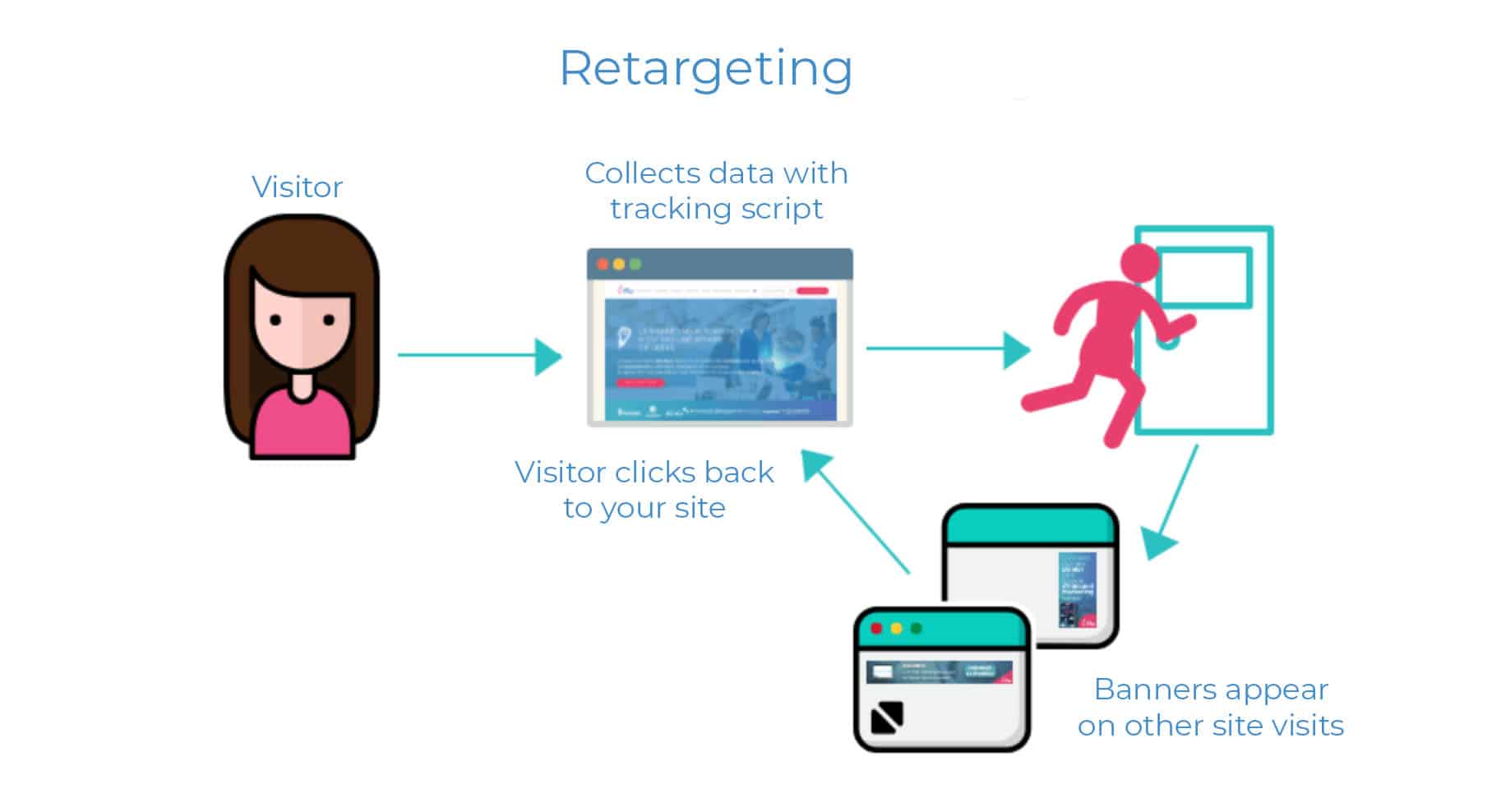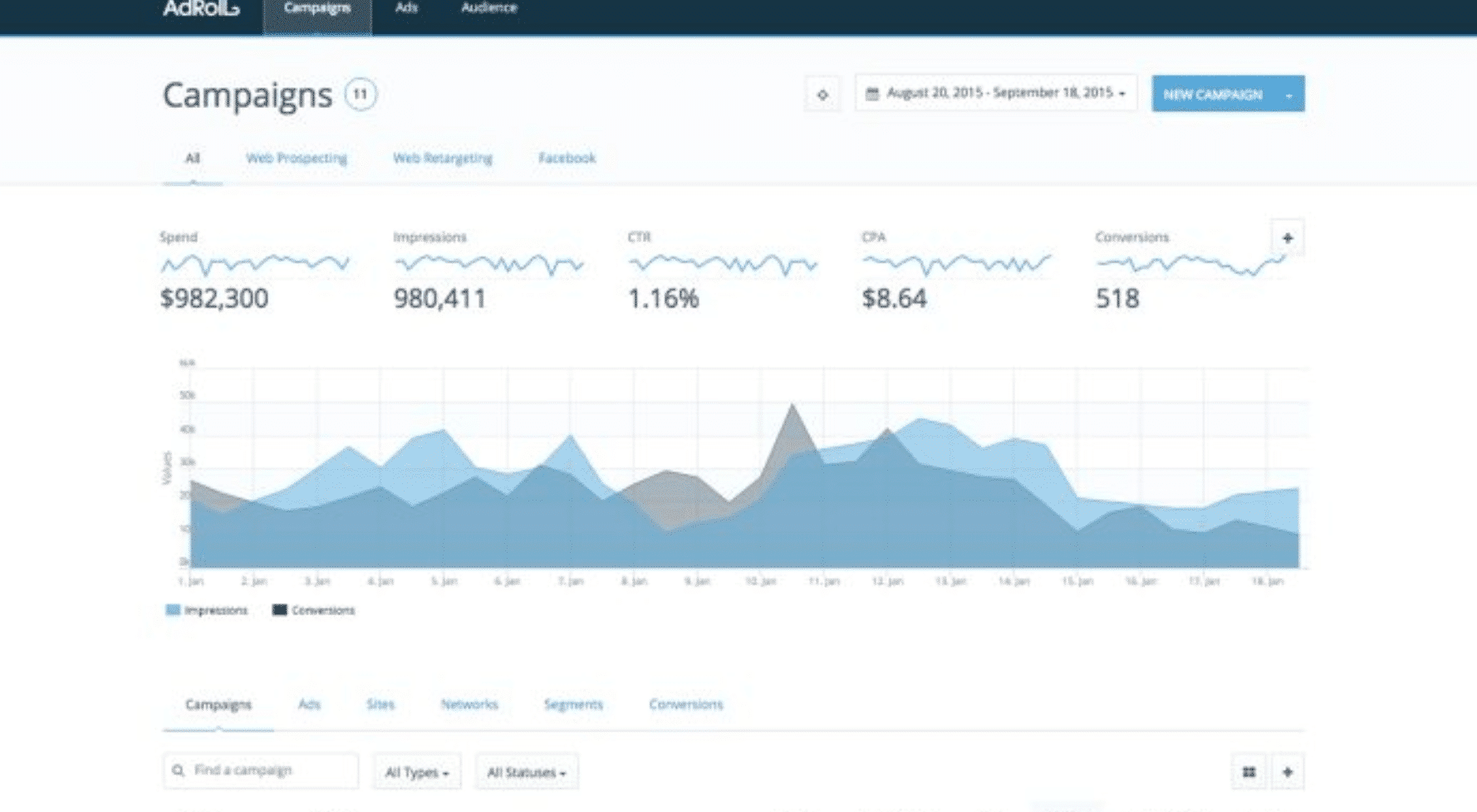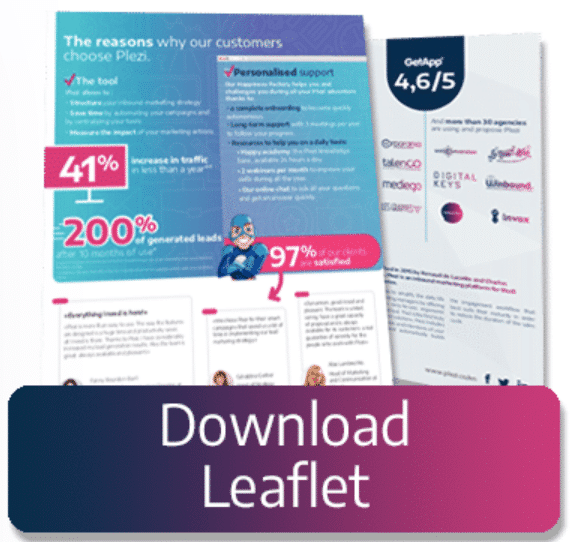How do you significantly improve your visitor to leads conversion rate in B2B? Retargeting is a way of pulling that visitor back into your funnel.
Let’s see how you can successfully implement it within an inbound marketing strategy and B2B lead generation.
- What is retargeting?
- What are you trying to achieve?
- Platforms suitable for B2B
- Steps and Best Practices to get started
01. What is retargeting?
Definition:
Retargeting consists of offering user-targeted advertising during future visits to other sites, based on behavioral data from someone’s browsing history.
So for Plezi, data is collected on the behavior of Internet users from a tracking code inserted in the pages of our website. This data is then transmitted to advertising agencies that have locations on other sites.
Retargeting or Remarketing?
Retargeting or remarketing? What’s the difference? None!
Remarketing is simply the nomenclature used by Google Ads on Adsense to differentiate themselves, but it is all one and the same thing.
We all know what retargeting is like when we’ve been looking at a pair of shoes online, say, and then they follow you around the internet FOR EVER! Even after you’ve bought them….
This is an example of where retargeting not only feels invasive, but also lacks intelligence and can sometimes put B2B marketers off. Let’s see if I can convince you otherwise.
The machinery of retargeting
Behind this simple idea, there is machinery, which is a little more complicated.
- When a person visits our site, they receive a browser cookie on their web browser which will allow information to be stored. This is done by placing a tracking script/code in the pages of the site.
- This data is collected by advertising agencies: their job is to obtain the maximum amount of advertising space on different websites. Very often located in sidebars, headers, footers, even in the texts of certain sites. This also includes placements in mobile apps.
- Agencies will then advertise our banners to people who have visited it on a multitude of other sites.
- Serving as a nagging reminder for the user to revisit the site, once, twice (three, four times…)

02. What are the goals of retargeting?
Retargeting is a tool that can be used for various strategies, both in B2C and B2B sales.
Improve Awareness
One of the main reasons companies use retargeting is for brand awareness. Banners improve the brands’ image.
Your companies logo, visual identity and messages are being reinforced, bit by bit. If you have a long sales cycle, this will reassure your prospective clients
At Plezi, we noticed a 13% increase for the term “Plezi” as a Google search after retargeting. So the side effect is that it also adds to the natural search reference of your site.
Loyalty
Retargeting can also help retain existing customers and to up-sell complementary products within that relationship.
What’s more, your visibility on other sites will reassure and add value to your offer. Especially if you offer marketing software, as we do….
Transform more leads…
Retargeting is an essential lever in an inbound B2B marketing strategy. A “normal” site converts around 2% of its visitors to B2B. Using retargeting can double this figure. Instead of converting only by the buttons and banners located your site, you can also convert later, on other sites, with various content. Retargeting can be used in two ways in inbound marketing:
- Improve acquisition by trying to capture the attention of people who’ve left your site
- Increase leads by bringing people back to your site to look at your offer.
03. Which platforms use retargeting?
There are several:
- Banner Retargeting: displayed by many sites and blogs, who monetise advertising.
- Social Media where banners and sponsored publications will display on social media and some partners.
- Email retargeting, more difficult after GDPR.
- Vidéo Retargeting, platforms such as Youtube
We’re going to look at both banners and social media – the most effective ROI for a B2B marketing strategy.
Adroll
Adroll has a very wide and reliable network of sites. You can start simply by retargeting and it has a clear and defined segmentation. Watch out though, it is quite complicated to understand their reports and pricing.
 Google Ads
Google Ads
Google Ads also offers retargeting with Adsense. You can take advantage of Google’s strength, which has caught up with Adroll in the last few years.
The big advantage of being able to rely on Google Analytics is to find the right audience and avoid adding an additional script.
LinkedIn Ads
LinkedIn Ads is the only professional social network of note. It can display sponsored content, but also banners or send emails based on a retargeted audience. This is a recent ad-on and means you need to install Insight Tag.
Twitter Ads
Twitter Ads are often seen as less significant for B2B. It’s true that it’s targeting can be “broad” at times, but it is excellent if you use it for sponsored tweets.
Facebook Ads
Facebook Ads can also be discouraging for B2B marketers. Again, really targeting your audience can be hard. And yet, so many people still use Facebook, that it can be really effective for retargeting, even more so than something such as Twitter.
04. Steps to get started
Define budget and targets
You don’t need a big budget to start retargeting – it’s another big advantage – rather than bidding on keywords (CPC), you’re targeting specific people. A retargeted audience is a ‘defined’ audience.
So, it’s possible to start retargeting with a budget of £300 a month.
The real limit is not the budget but the minimum audience for retargeting which must be 1000 visitors per month for most platforms like Google Ads (Adwords) or Adroll.
The other prerequisite is to make it actually work for you in B2B. Bringing customers back to your site is great, but there must be a metric to understand why.
Brand Awareness :
You can analyze how much traffic retargeting brings you, as well as where that traffic comes from. Here conversion is not a priority, you want to boost your brand.
Leads :
You can also define who your visitors are by converting them into leads. Pages visitors are sent to where they leave their contact details. This can be easily automated with marketing software.
You can also monitor that with a Thank You page, rather than a script, saving you time when setting up campaigns on the platforms above.
In this instance, it is important to promote premium content, so that visitors are required to leave their contact details.
Lead nurturing :
Prospects who have left their contact details can be nurtured easily by a platform like Plezi, through email, but it can also be coupled with retargeting, to maximise the impact.
What we are trying to do is understand the maturity of the contact with the sales cycle.
For example, a prospect downloads a white paper and gets 15 points. They click from a Facebook ad on an article about “the advantages of marketing automation software in a digital marketing strategy”, and get 5 more points. The prospect can then be automatically sent to your CRM, where a salesperson can contact them as a lead that is ready.
Get started step by step
To start retargeting, you need:
- 1 000 visitors a month
- thank you pages / defined objectives
- £100 budget per month minimum
- content to promote: white papers, webinars, case studies, testimonials, or simply a demo or product documentation.
- A landing page
Once you’ve got all that, you have to decide which platform to use. We can think of two types:
- Banner Platforms: Google Ads and Adroll
- Socials Platforms: LinkedIn, Twitter and Facebook Ads
Creating the banners themselves is also necessary. In fact, you’ll need to create up to 7 different ones
- 160 x 600 pixels
- 300 x 250 pixels
- 300 x 600 pixels
- 320 x 50 pixels
- 728 x 90 pixels
- 970 x 250 pixels
- 1200 x 630 pixels
To launch advertising campaigns on social networks, you only need the latest format (1200 x 630px), while Google Ads and Adroll use the first 6 formats. That may sway your choice to begin with!
We would advise creating a banner that is 1200x630px for the content you want to push and several key messages so you have different ads.
It is possible to retarget on social media bit by bit, starting on one and moving on to more. Each platform will also need a tracking code so you can measure performance.
With Google Ads you can also generate “responsive” ads which can adapt to all formats.
Best practice to create an effective led machine
Once launched campaigns can be enhanced with new content and duplicated on different channels. After that, you need to monitor the budget accordingly and refine the targeting.
- It is possible to vary the content of the ads: you can create ad content by content
- Create content groups and segment the ads according to the pages viewed on your site, adopt the same tactic accordingly with marketing automation software.
- Exclude people who have already downloaded content – so you don’t start spamming them.
- Exclude people who are outside of your target group
- Monitor the cost of acquiring potential customers. At Plezi, we try to keep it under £10.
- Vary the ads, the pitch, and refresh the publications on social networks every 2-3 months ….
Retargeting is a key element of a good digital strategy, especially in BtoB where sales cycles are long and will require implementing a real multi-channel web marketing strategy. We hope that with this guide you’re on your way to getting started.






 Google Ads
Google Ads
